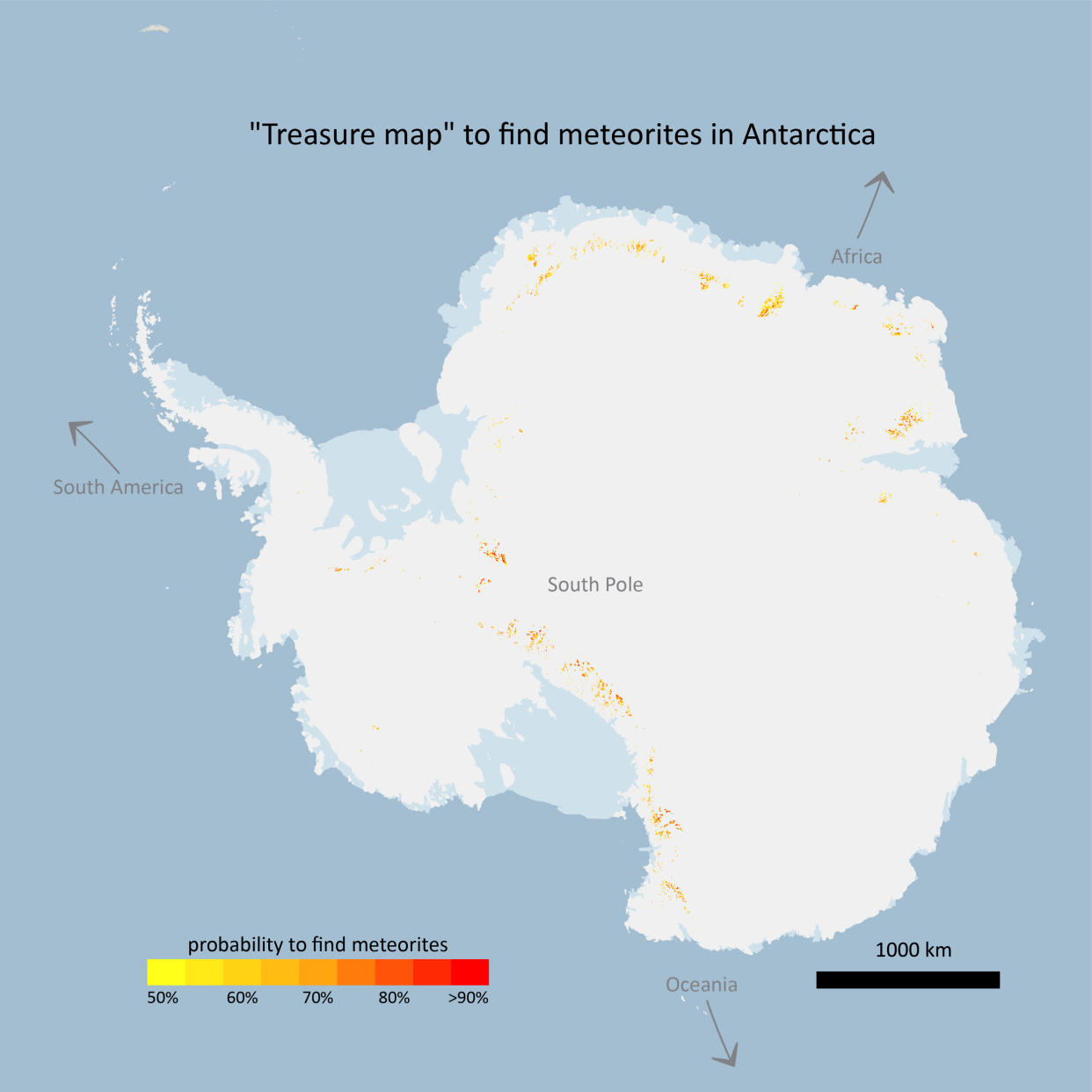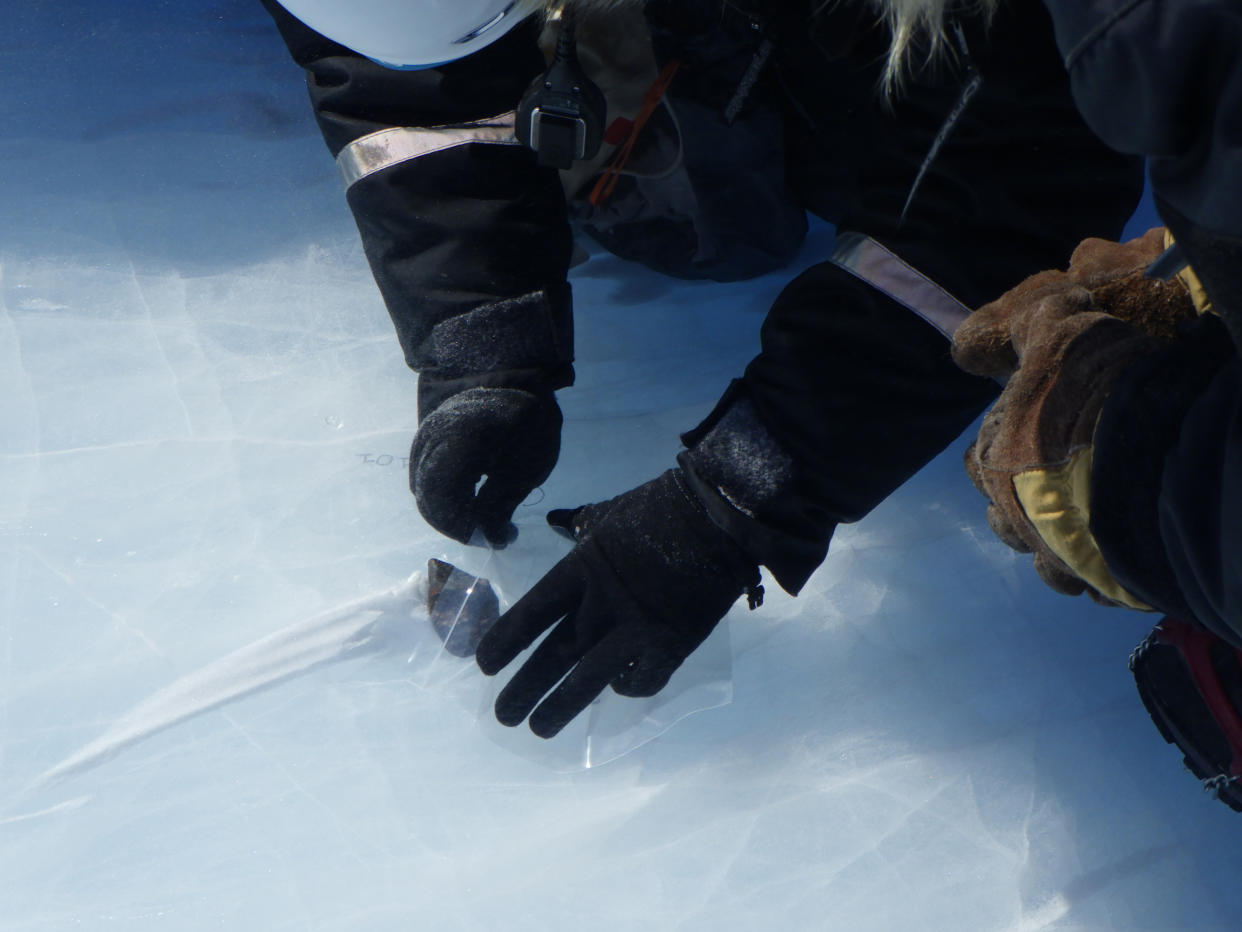On the hunt for meteorites, researchers look to a data-based 'treasure map'
Scattered like confetti across the frozen wasteland of Antarctica, extraterrestrial time capsules containing clues to how the planets formed and the origins of life itself are waiting to be discovered.
Hundreds of thousands of meteorites remain on or just beneath the subzero surface, offering scientists a tantalizing glimpse into the beginnings of our solar system. A half-century of retrieval operations have turned up some spectacular finds, including fragments from the moon and Mars.
Yet, Antarctic meteorite expeditions are more or less potluck: many missions return, after much cost and no little danger, empty-handed.
“Currently, it’s all trial-and-error,” said Steven Goderis, a geochemist at Brussels’ Vrije University. “Visit an ice field during a reconnaissance mission and see what you get, often based on chance and past experience.”

Now, a Belgian-Dutch team of scientists says it has created the first “treasure map” showing where meteorites may be found, using machine learning to better the odds of researchers retrieving the space rocks, according to a study published Wednesday in the journal Science Advances.
Around 45,000 meteorites have been collected from Antarctica, nearly two-thirds of all meteorites found so far on Earth.
“There are probably fewer meteorites falling per acre of land in Antarctica than in other parts of the world,” said Ralph Harvey, principal investigator at the National Science Foundation’s Antarctic Search for Meteorites program and a professor at Case Western Reserve University.
“But if you want to find things that fell from the sky, lay out a big white sheet. And Antarctica is a 5,000-kilometer-wide sheet.”
The meteorites are not dispersed equally. On landing, they embed themselves in the ice sheet. Over time, they move as the ice moves, pushed toward the ocean and thrust upward to the surface into what are called blue ice areas.
He said local conditions such as temperature, wind velocity and topography can make meteorite hunting a game of chance.
“We’ll go to an ice sheet where we think conditions are great, and we’ll search an area the size of a tennis court and find 100 specimens on it,” Harvey, who has taken part in 24 Antarctic missions, said. “Then we’ll search an area the size of Delaware and we’ll find nothing.”

In 2012, Harry Zekollari, now a postdoctoral researcher at ETH Zurich, joined a Belgian-Japanese retrieval mission on the Nansen ice field, some 3,000 miles south of New Zealand.
The expedition unearthed more than 400 meteorites, including an object known as Asuka 12236. About 4.5 billion years old, Asuka 12236 was found to contain amino acids that offered clues as to how life appeared on Earth.
Zekollari realized that the objects had been missed by another expedition a few decades earlier, proof that the meteorites can hide in plain sight, and that there may be a way of better predicting where they are likely to be.
“We knew that we could get a lot out of satellite data because there are some characteristics you need such as slow velocities of ice movement and that the ice needs to be cold,” he said.
“But we also quickly knew that it’s not simply that we saw these conditions so there must be meteorites here. There was an interaction, and to get that interaction we really needed machine learning.”
Zekollari and his team used data from previous expeditions, as well as satellite imagery, to identify four key conditions that could predict the presence of meteorites in a given area. They then fed these observations into an algorithm to create their map.
“We had the continentwide data and we knew places where they already found meteorites that we could use to train the algorithm,” said Veronica Tollenaar, a doctoral fellow at the Université Libre de Bruxelles in Brussels.
“But we also needed data from places where they did not find meteorites. This was kind of challenging because there is very little data on unsuccessful missions. ”
These “unsuccessful” missions were left unlabeled, leaving the algorithm to infer based on an interplay of temperature, ice velocity, slope and radar data, whether or not an area was likely to contain meteorites.
Testing the machine’s accuracy using independent expedition data, the team found it was correct more than 80 percent of the time. All told, it estimates that there are 300,000 to 900,000 pieces of space rock still undiscovered across Antarctica.
And thanks to the Antarctic Treaty, which classifies the continent as a giant reserve owned by no single country, the meteorites found there belong to the international scientific community — a kind of astrogeological Creative Commons.
“That’s a big contrast to meteorites found in North Africa, because the finder owns them and it is very hard to use them for research,” said Tollenaar, lead author of the study published in Science Advances.
“There is monetary value in these things, and that is hampering science a lot. It’s very beautiful to own a meteorite but if you can learn from it, I would say that’s even more beautiful.”
The team stresses its map does not guarantee all future expeditions will find meteorites.
“The disclaimer is this is just based on modeling,” Zekollari said. “But we hope it can make some missions more successful.”
However, the task of getting to some of the remotest and most inhospitable regions on the planet remains.
“Logistically, it’s super difficult,” Tollenaar said. “Dangerous, even. There are lots of areas where people have never been. It’s exploring our own planet while finding other planets.”
